Innovation and Entrepreneurship: Business Plan Project, ENT6800 Module
VerifiedAdded on 2022/12/01
|11
|3244
|313
Project
AI Summary
This assignment presents a comprehensive business plan project focused on innovation and entrepreneurship. It begins with an introduction to the concepts of entrepreneurship and innovation, emphasizing their role in value creation. The main body of the assignment outlines the steps involved in developing a new business start-up idea, including market research, business plan creation, budgeting, legal entity decisions, and securing a website. A business profile of ALDI is provided, detailing its history, target market, and core values. The assignment then delves into the Aldi's business model, analyzing its key components using Porter's Five Forces. Furthermore, it discusses the factors that differentiate Aldi from its competitors and the challenges faced by start-ups, such as lack of technology and inadequate marketing. A detailed marketing plan, including product, price, and place strategies, is also included. The assignment concludes with a review of the key takeaways and references used.
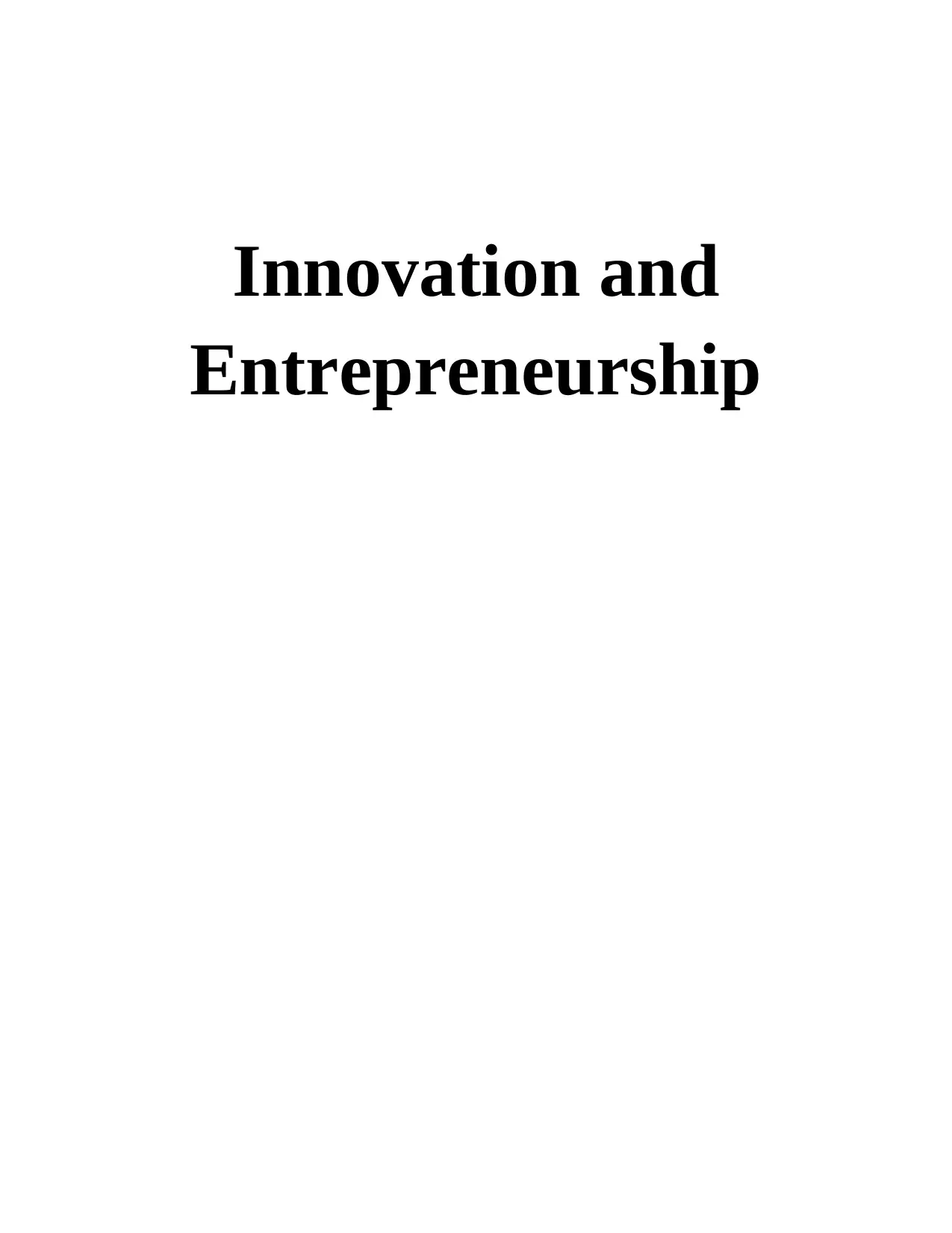
Innovation and
Entrepreneurship
Entrepreneurship
Paraphrase This Document
Need a fresh take? Get an instant paraphrase of this document with our AI Paraphraser
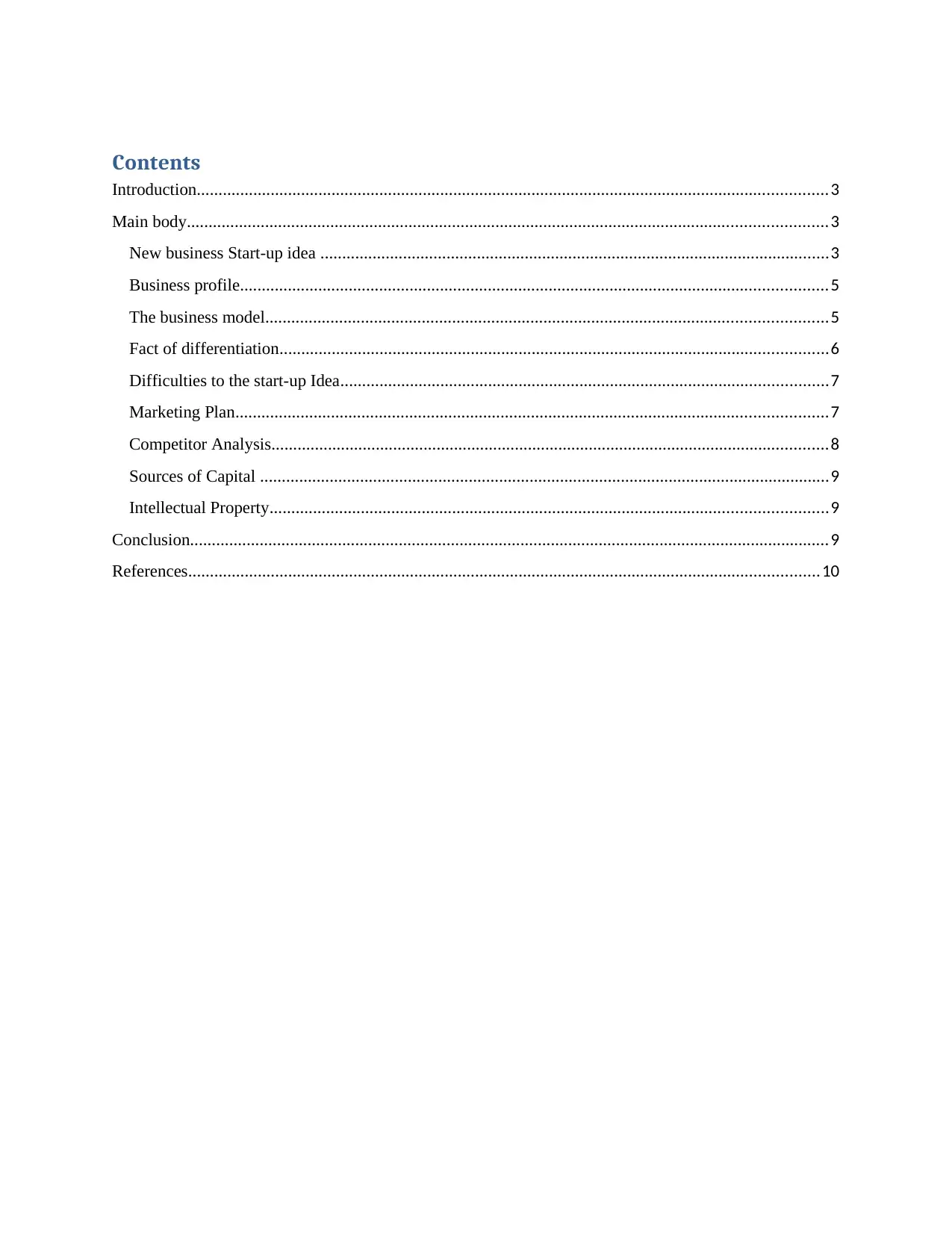
Contents
Introduction.................................................................................................................................................3
Main body...................................................................................................................................................3
New business Start-up idea .....................................................................................................................3
Business profile.......................................................................................................................................5
The business model.................................................................................................................................5
Fact of differentiation..............................................................................................................................6
Difficulties to the start-up Idea................................................................................................................7
Marketing Plan........................................................................................................................................7
Competitor Analysis................................................................................................................................8
Sources of Capital ...................................................................................................................................9
Intellectual Property................................................................................................................................9
Conclusion...................................................................................................................................................9
References.................................................................................................................................................10
Introduction.................................................................................................................................................3
Main body...................................................................................................................................................3
New business Start-up idea .....................................................................................................................3
Business profile.......................................................................................................................................5
The business model.................................................................................................................................5
Fact of differentiation..............................................................................................................................6
Difficulties to the start-up Idea................................................................................................................7
Marketing Plan........................................................................................................................................7
Competitor Analysis................................................................................................................................8
Sources of Capital ...................................................................................................................................9
Intellectual Property................................................................................................................................9
Conclusion...................................................................................................................................................9
References.................................................................................................................................................10
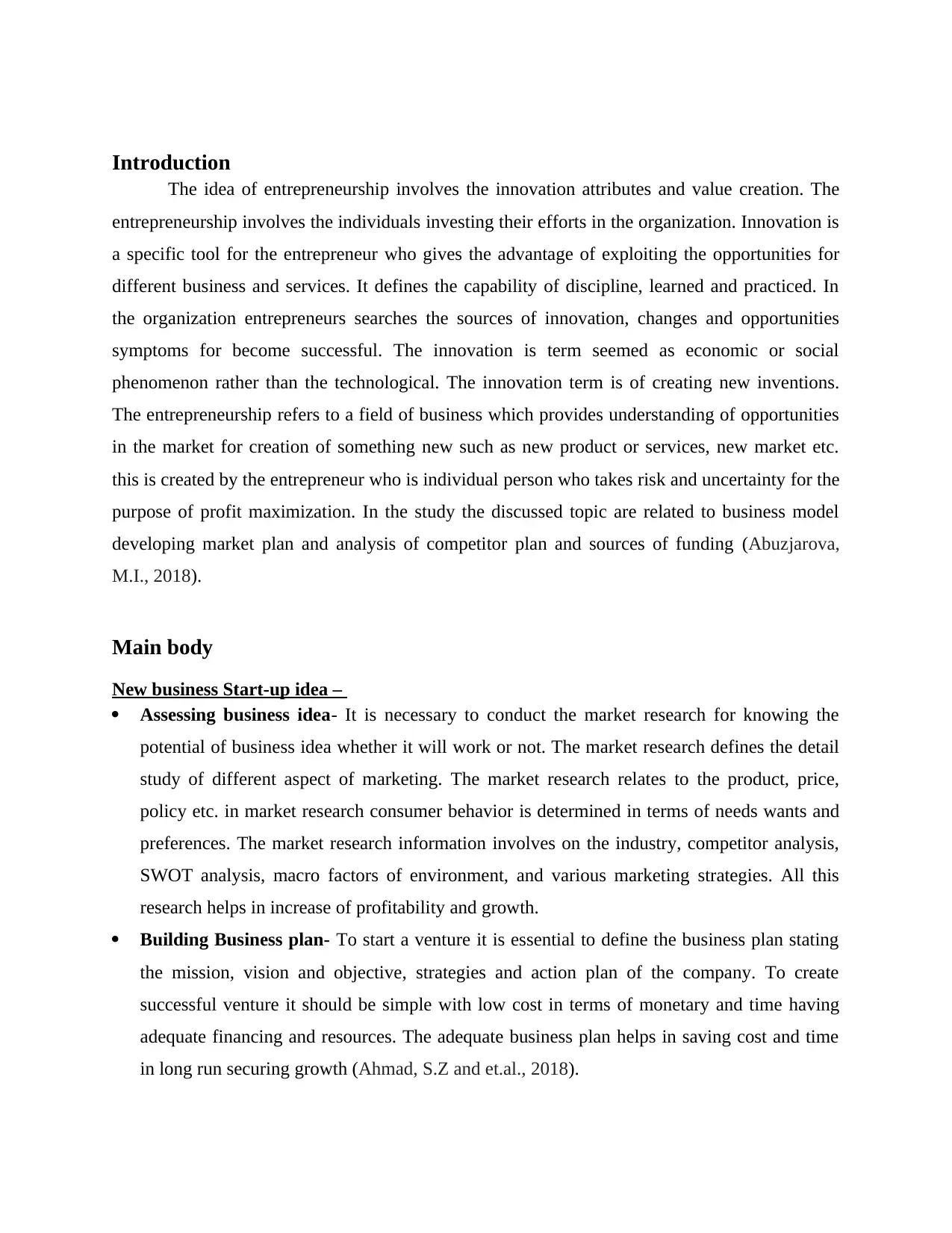
Introduction
The idea of entrepreneurship involves the innovation attributes and value creation. The
entrepreneurship involves the individuals investing their efforts in the organization. Innovation is
a specific tool for the entrepreneur who gives the advantage of exploiting the opportunities for
different business and services. It defines the capability of discipline, learned and practiced. In
the organization entrepreneurs searches the sources of innovation, changes and opportunities
symptoms for become successful. The innovation is term seemed as economic or social
phenomenon rather than the technological. The innovation term is of creating new inventions.
The entrepreneurship refers to a field of business which provides understanding of opportunities
in the market for creation of something new such as new product or services, new market etc.
this is created by the entrepreneur who is individual person who takes risk and uncertainty for the
purpose of profit maximization. In the study the discussed topic are related to business model
developing market plan and analysis of competitor plan and sources of funding (Abuzjarova,
M.I., 2018).
Main body
New business Start-up idea –
Assessing business idea- It is necessary to conduct the market research for knowing the
potential of business idea whether it will work or not. The market research defines the detail
study of different aspect of marketing. The market research relates to the product, price,
policy etc. in market research consumer behavior is determined in terms of needs wants and
preferences. The market research information involves on the industry, competitor analysis,
SWOT analysis, macro factors of environment, and various marketing strategies. All this
research helps in increase of profitability and growth.
Building Business plan- To start a venture it is essential to define the business plan stating
the mission, vision and objective, strategies and action plan of the company. To create
successful venture it should be simple with low cost in terms of monetary and time having
adequate financing and resources. The adequate business plan helps in saving cost and time
in long run securing growth (Ahmad, S.Z and et.al., 2018).
The idea of entrepreneurship involves the innovation attributes and value creation. The
entrepreneurship involves the individuals investing their efforts in the organization. Innovation is
a specific tool for the entrepreneur who gives the advantage of exploiting the opportunities for
different business and services. It defines the capability of discipline, learned and practiced. In
the organization entrepreneurs searches the sources of innovation, changes and opportunities
symptoms for become successful. The innovation is term seemed as economic or social
phenomenon rather than the technological. The innovation term is of creating new inventions.
The entrepreneurship refers to a field of business which provides understanding of opportunities
in the market for creation of something new such as new product or services, new market etc.
this is created by the entrepreneur who is individual person who takes risk and uncertainty for the
purpose of profit maximization. In the study the discussed topic are related to business model
developing market plan and analysis of competitor plan and sources of funding (Abuzjarova,
M.I., 2018).
Main body
New business Start-up idea –
Assessing business idea- It is necessary to conduct the market research for knowing the
potential of business idea whether it will work or not. The market research defines the detail
study of different aspect of marketing. The market research relates to the product, price,
policy etc. in market research consumer behavior is determined in terms of needs wants and
preferences. The market research information involves on the industry, competitor analysis,
SWOT analysis, macro factors of environment, and various marketing strategies. All this
research helps in increase of profitability and growth.
Building Business plan- To start a venture it is essential to define the business plan stating
the mission, vision and objective, strategies and action plan of the company. To create
successful venture it should be simple with low cost in terms of monetary and time having
adequate financing and resources. The adequate business plan helps in saving cost and time
in long run securing growth (Ahmad, S.Z and et.al., 2018).
⊘ This is a preview!⊘
Do you want full access?
Subscribe today to unlock all pages.

Trusted by 1+ million students worldwide
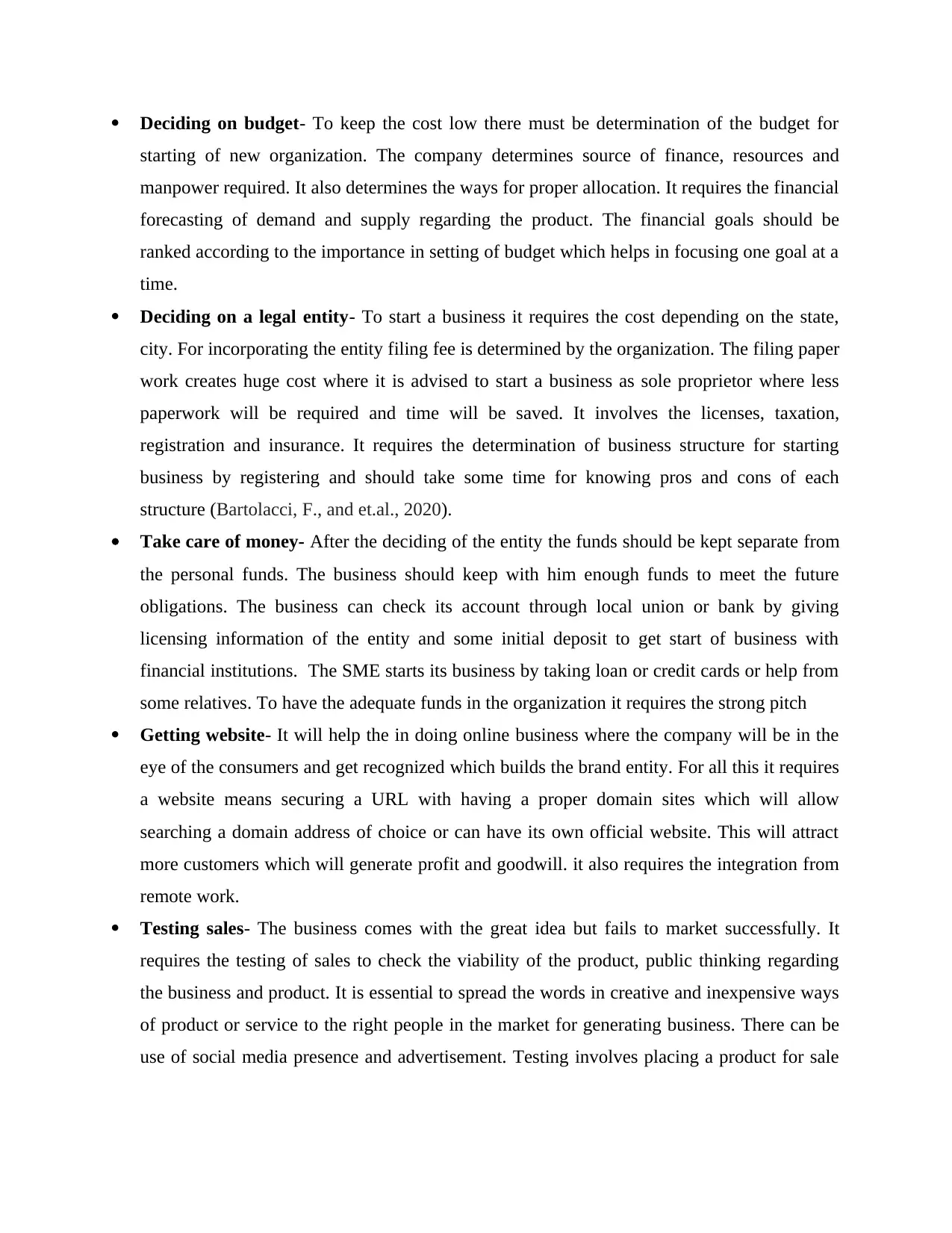
Deciding on budget- To keep the cost low there must be determination of the budget for
starting of new organization. The company determines source of finance, resources and
manpower required. It also determines the ways for proper allocation. It requires the financial
forecasting of demand and supply regarding the product. The financial goals should be
ranked according to the importance in setting of budget which helps in focusing one goal at a
time.
Deciding on a legal entity- To start a business it requires the cost depending on the state,
city. For incorporating the entity filing fee is determined by the organization. The filing paper
work creates huge cost where it is advised to start a business as sole proprietor where less
paperwork will be required and time will be saved. It involves the licenses, taxation,
registration and insurance. It requires the determination of business structure for starting
business by registering and should take some time for knowing pros and cons of each
structure (Bartolacci, F., and et.al., 2020).
Take care of money- After the deciding of the entity the funds should be kept separate from
the personal funds. The business should keep with him enough funds to meet the future
obligations. The business can check its account through local union or bank by giving
licensing information of the entity and some initial deposit to get start of business with
financial institutions. The SME starts its business by taking loan or credit cards or help from
some relatives. To have the adequate funds in the organization it requires the strong pitch
Getting website- It will help the in doing online business where the company will be in the
eye of the consumers and get recognized which builds the brand entity. For all this it requires
a website means securing a URL with having a proper domain sites which will allow
searching a domain address of choice or can have its own official website. This will attract
more customers which will generate profit and goodwill. it also requires the integration from
remote work.
Testing sales- The business comes with the great idea but fails to market successfully. It
requires the testing of sales to check the viability of the product, public thinking regarding
the business and product. It is essential to spread the words in creative and inexpensive ways
of product or service to the right people in the market for generating business. There can be
use of social media presence and advertisement. Testing involves placing a product for sale
starting of new organization. The company determines source of finance, resources and
manpower required. It also determines the ways for proper allocation. It requires the financial
forecasting of demand and supply regarding the product. The financial goals should be
ranked according to the importance in setting of budget which helps in focusing one goal at a
time.
Deciding on a legal entity- To start a business it requires the cost depending on the state,
city. For incorporating the entity filing fee is determined by the organization. The filing paper
work creates huge cost where it is advised to start a business as sole proprietor where less
paperwork will be required and time will be saved. It involves the licenses, taxation,
registration and insurance. It requires the determination of business structure for starting
business by registering and should take some time for knowing pros and cons of each
structure (Bartolacci, F., and et.al., 2020).
Take care of money- After the deciding of the entity the funds should be kept separate from
the personal funds. The business should keep with him enough funds to meet the future
obligations. The business can check its account through local union or bank by giving
licensing information of the entity and some initial deposit to get start of business with
financial institutions. The SME starts its business by taking loan or credit cards or help from
some relatives. To have the adequate funds in the organization it requires the strong pitch
Getting website- It will help the in doing online business where the company will be in the
eye of the consumers and get recognized which builds the brand entity. For all this it requires
a website means securing a URL with having a proper domain sites which will allow
searching a domain address of choice or can have its own official website. This will attract
more customers which will generate profit and goodwill. it also requires the integration from
remote work.
Testing sales- The business comes with the great idea but fails to market successfully. It
requires the testing of sales to check the viability of the product, public thinking regarding
the business and product. It is essential to spread the words in creative and inexpensive ways
of product or service to the right people in the market for generating business. There can be
use of social media presence and advertisement. Testing involves placing a product for sale
Paraphrase This Document
Need a fresh take? Get an instant paraphrase of this document with our AI Paraphraser
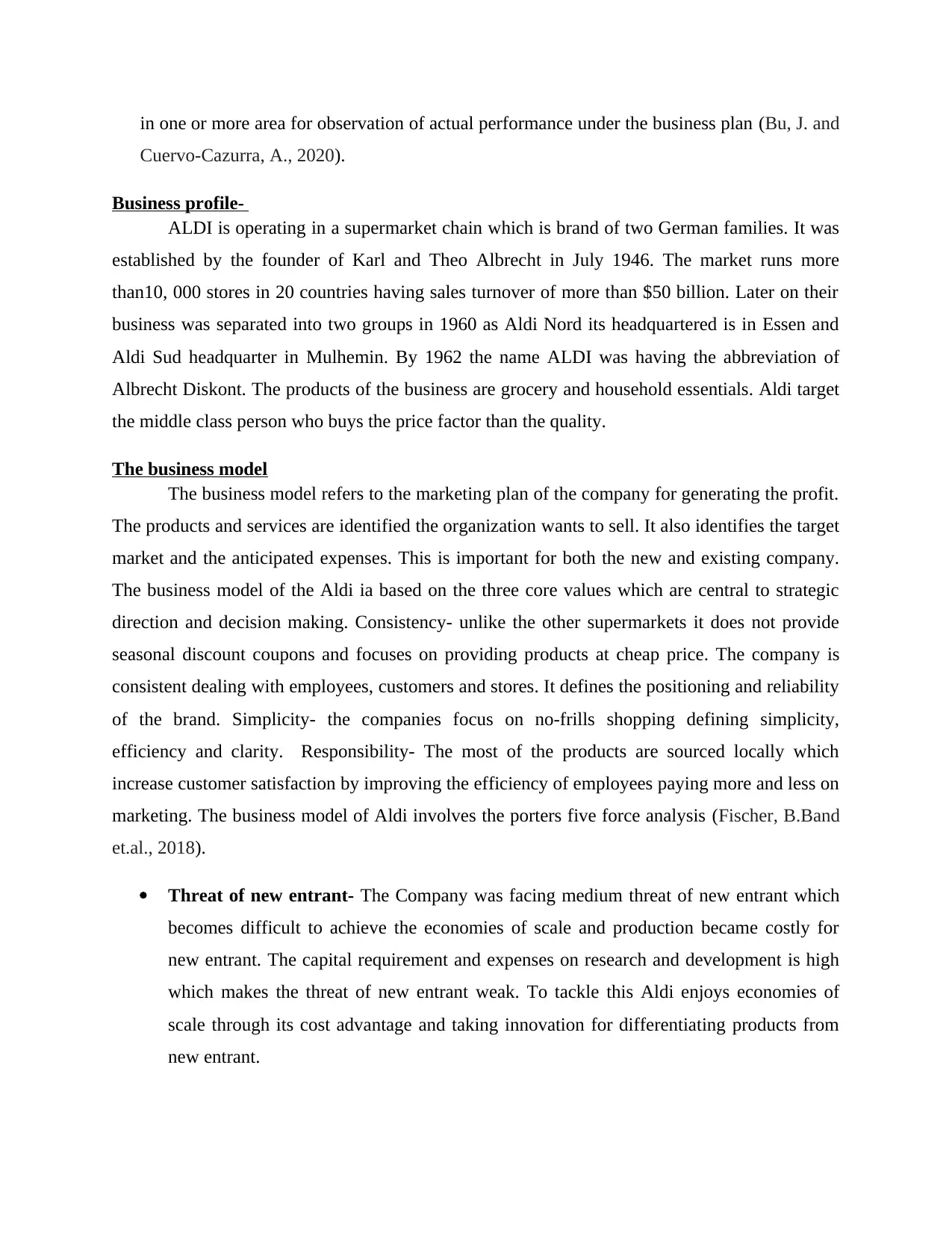
in one or more area for observation of actual performance under the business plan (Bu, J. and
Cuervo‐Cazurra, A., 2020).
Business profile-
ALDI is operating in a supermarket chain which is brand of two German families. It was
established by the founder of Karl and Theo Albrecht in July 1946. The market runs more
than10, 000 stores in 20 countries having sales turnover of more than $50 billion. Later on their
business was separated into two groups in 1960 as Aldi Nord its headquartered is in Essen and
Aldi Sud headquarter in Mulhemin. By 1962 the name ALDI was having the abbreviation of
Albrecht Diskont. The products of the business are grocery and household essentials. Aldi target
the middle class person who buys the price factor than the quality.
The business model
The business model refers to the marketing plan of the company for generating the profit.
The products and services are identified the organization wants to sell. It also identifies the target
market and the anticipated expenses. This is important for both the new and existing company.
The business model of the Aldi ia based on the three core values which are central to strategic
direction and decision making. Consistency- unlike the other supermarkets it does not provide
seasonal discount coupons and focuses on providing products at cheap price. The company is
consistent dealing with employees, customers and stores. It defines the positioning and reliability
of the brand. Simplicity- the companies focus on no-frills shopping defining simplicity,
efficiency and clarity. Responsibility- The most of the products are sourced locally which
increase customer satisfaction by improving the efficiency of employees paying more and less on
marketing. The business model of Aldi involves the porters five force analysis (Fischer, B.Band
et.al., 2018).
Threat of new entrant- The Company was facing medium threat of new entrant which
becomes difficult to achieve the economies of scale and production became costly for
new entrant. The capital requirement and expenses on research and development is high
which makes the threat of new entrant weak. To tackle this Aldi enjoys economies of
scale through its cost advantage and taking innovation for differentiating products from
new entrant.
Cuervo‐Cazurra, A., 2020).
Business profile-
ALDI is operating in a supermarket chain which is brand of two German families. It was
established by the founder of Karl and Theo Albrecht in July 1946. The market runs more
than10, 000 stores in 20 countries having sales turnover of more than $50 billion. Later on their
business was separated into two groups in 1960 as Aldi Nord its headquartered is in Essen and
Aldi Sud headquarter in Mulhemin. By 1962 the name ALDI was having the abbreviation of
Albrecht Diskont. The products of the business are grocery and household essentials. Aldi target
the middle class person who buys the price factor than the quality.
The business model
The business model refers to the marketing plan of the company for generating the profit.
The products and services are identified the organization wants to sell. It also identifies the target
market and the anticipated expenses. This is important for both the new and existing company.
The business model of the Aldi ia based on the three core values which are central to strategic
direction and decision making. Consistency- unlike the other supermarkets it does not provide
seasonal discount coupons and focuses on providing products at cheap price. The company is
consistent dealing with employees, customers and stores. It defines the positioning and reliability
of the brand. Simplicity- the companies focus on no-frills shopping defining simplicity,
efficiency and clarity. Responsibility- The most of the products are sourced locally which
increase customer satisfaction by improving the efficiency of employees paying more and less on
marketing. The business model of Aldi involves the porters five force analysis (Fischer, B.Band
et.al., 2018).
Threat of new entrant- The Company was facing medium threat of new entrant which
becomes difficult to achieve the economies of scale and production became costly for
new entrant. The capital requirement and expenses on research and development is high
which makes the threat of new entrant weak. To tackle this Aldi enjoys economies of
scale through its cost advantage and taking innovation for differentiating products from
new entrant.

Bargaining Power of Suppliers- The supplier power is weak is it has less control over
prices and no substitute is available. The Aldi was facing low power of supplier as the
retail industry has lot of supplier supplying the same product at the current market price
or at fewer prices which force the supplier to provide discounts by retailer and no
switching cost was involved. The company was having the right to switch its supplier and
purchases raw material at low cost by establishing close relationship with the supplier
(Henderson, D., 2019).
Bargaining Power of Buyers- The power of buyer is high in Aldi as product is provided
at low cost to the consumer. The product differentiation is high and income level of the
buyer is low. The company does not provide any discount and not having the influence
on the price of market products. The product is provided to low income group at lower
price for customer retention. Aldi focus on innovation and product differentiation for
attracting more consumers which creates large base of customer.
Threat of Substitute Products or Services- The Company was facing high threat of
substitute as Aldi sell unique products by focusing on great quality which is sold by other
supermarket. The market in which company operates little substitutes is available which
create low profit earning. Exclusive benefits are provided to the customers by
determining their needs and understanding through market and research. The company
increase its sales customers as need quality product at affordable price which shifts them
from the substitute product (Lytras, M.D and et.al., 2017).
Rivalry Among Existing Firms- The Company was facing high competition as various
supermarkets were offering the product at the same price. The competitors are Wal-Mart,
Morrison’s, and Sainsbury etc. It applied the principle of minimizing fixed cost. For
gaining position of market leader the competitors have large market share. As few
competitors were engaged in the competitive action of finding new customers which
increased the growth of the company by having market research for gaining the
understanding of demand and supply.
Fact of differentiation
The Aldi is unique in a several ways comparing to other grocery stores as the stores are
much smaller opened during busy shopping hours for keeping labor cost down. It has 1-2
prices and no substitute is available. The Aldi was facing low power of supplier as the
retail industry has lot of supplier supplying the same product at the current market price
or at fewer prices which force the supplier to provide discounts by retailer and no
switching cost was involved. The company was having the right to switch its supplier and
purchases raw material at low cost by establishing close relationship with the supplier
(Henderson, D., 2019).
Bargaining Power of Buyers- The power of buyer is high in Aldi as product is provided
at low cost to the consumer. The product differentiation is high and income level of the
buyer is low. The company does not provide any discount and not having the influence
on the price of market products. The product is provided to low income group at lower
price for customer retention. Aldi focus on innovation and product differentiation for
attracting more consumers which creates large base of customer.
Threat of Substitute Products or Services- The Company was facing high threat of
substitute as Aldi sell unique products by focusing on great quality which is sold by other
supermarket. The market in which company operates little substitutes is available which
create low profit earning. Exclusive benefits are provided to the customers by
determining their needs and understanding through market and research. The company
increase its sales customers as need quality product at affordable price which shifts them
from the substitute product (Lytras, M.D and et.al., 2017).
Rivalry Among Existing Firms- The Company was facing high competition as various
supermarkets were offering the product at the same price. The competitors are Wal-Mart,
Morrison’s, and Sainsbury etc. It applied the principle of minimizing fixed cost. For
gaining position of market leader the competitors have large market share. As few
competitors were engaged in the competitive action of finding new customers which
increased the growth of the company by having market research for gaining the
understanding of demand and supply.
Fact of differentiation
The Aldi is unique in a several ways comparing to other grocery stores as the stores are
much smaller opened during busy shopping hours for keeping labor cost down. It has 1-2
⊘ This is a preview!⊘
Do you want full access?
Subscribe today to unlock all pages.

Trusted by 1+ million students worldwide
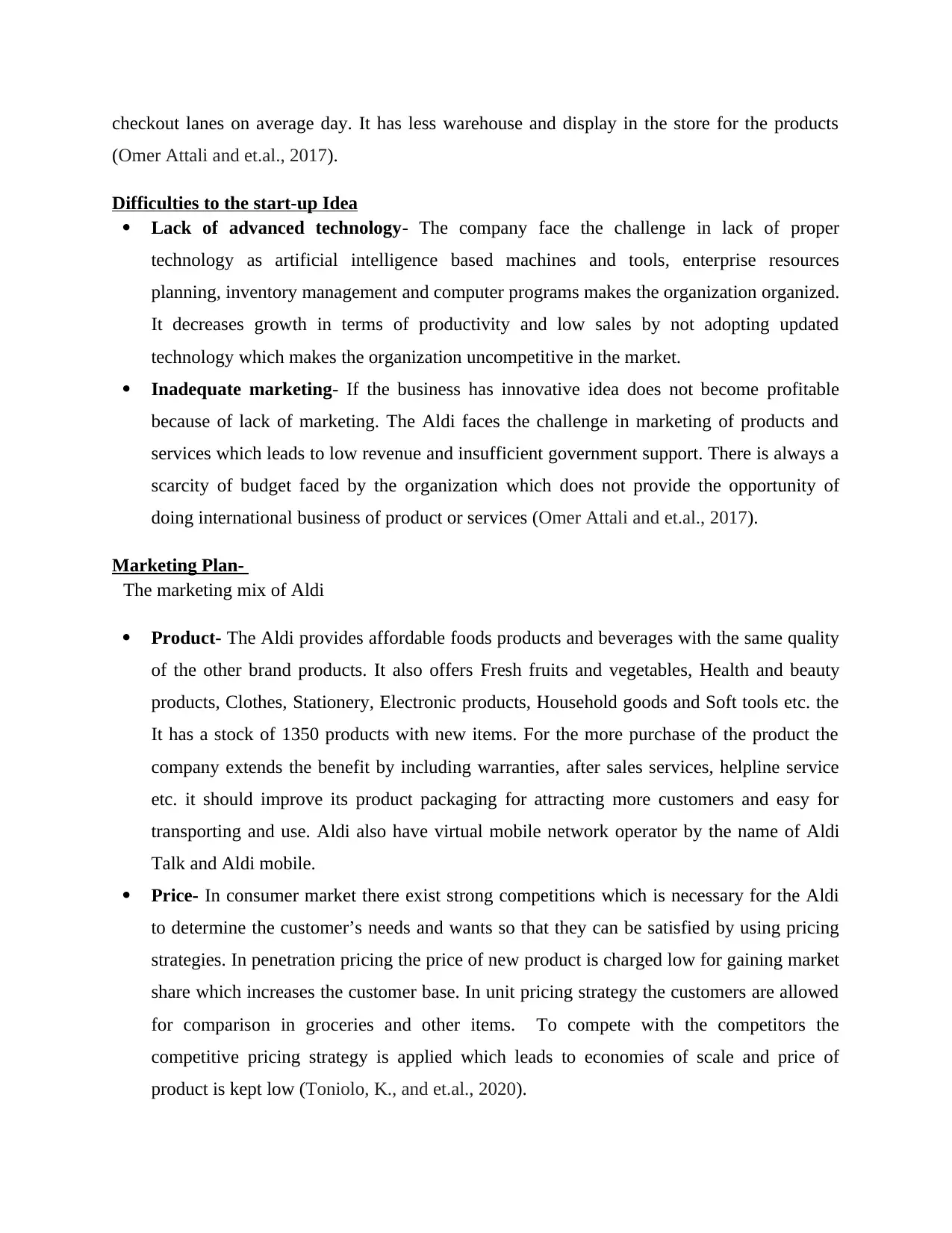
checkout lanes on average day. It has less warehouse and display in the store for the products
(Omer Attali and et.al., 2017).
Difficulties to the start-up Idea
Lack of advanced technology- The company face the challenge in lack of proper
technology as artificial intelligence based machines and tools, enterprise resources
planning, inventory management and computer programs makes the organization organized.
It decreases growth in terms of productivity and low sales by not adopting updated
technology which makes the organization uncompetitive in the market.
Inadequate marketing- If the business has innovative idea does not become profitable
because of lack of marketing. The Aldi faces the challenge in marketing of products and
services which leads to low revenue and insufficient government support. There is always a
scarcity of budget faced by the organization which does not provide the opportunity of
doing international business of product or services (Omer Attali and et.al., 2017).
Marketing Plan-
The marketing mix of Aldi
Product- The Aldi provides affordable foods products and beverages with the same quality
of the other brand products. It also offers Fresh fruits and vegetables, Health and beauty
products, Clothes, Stationery, Electronic products, Household goods and Soft tools etc. the
It has a stock of 1350 products with new items. For the more purchase of the product the
company extends the benefit by including warranties, after sales services, helpline service
etc. it should improve its product packaging for attracting more customers and easy for
transporting and use. Aldi also have virtual mobile network operator by the name of Aldi
Talk and Aldi mobile.
Price- In consumer market there exist strong competitions which is necessary for the Aldi
to determine the customer’s needs and wants so that they can be satisfied by using pricing
strategies. In penetration pricing the price of new product is charged low for gaining market
share which increases the customer base. In unit pricing strategy the customers are allowed
for comparison in groceries and other items. To compete with the competitors the
competitive pricing strategy is applied which leads to economies of scale and price of
product is kept low (Toniolo, K., and et.al., 2020).
(Omer Attali and et.al., 2017).
Difficulties to the start-up Idea
Lack of advanced technology- The company face the challenge in lack of proper
technology as artificial intelligence based machines and tools, enterprise resources
planning, inventory management and computer programs makes the organization organized.
It decreases growth in terms of productivity and low sales by not adopting updated
technology which makes the organization uncompetitive in the market.
Inadequate marketing- If the business has innovative idea does not become profitable
because of lack of marketing. The Aldi faces the challenge in marketing of products and
services which leads to low revenue and insufficient government support. There is always a
scarcity of budget faced by the organization which does not provide the opportunity of
doing international business of product or services (Omer Attali and et.al., 2017).
Marketing Plan-
The marketing mix of Aldi
Product- The Aldi provides affordable foods products and beverages with the same quality
of the other brand products. It also offers Fresh fruits and vegetables, Health and beauty
products, Clothes, Stationery, Electronic products, Household goods and Soft tools etc. the
It has a stock of 1350 products with new items. For the more purchase of the product the
company extends the benefit by including warranties, after sales services, helpline service
etc. it should improve its product packaging for attracting more customers and easy for
transporting and use. Aldi also have virtual mobile network operator by the name of Aldi
Talk and Aldi mobile.
Price- In consumer market there exist strong competitions which is necessary for the Aldi
to determine the customer’s needs and wants so that they can be satisfied by using pricing
strategies. In penetration pricing the price of new product is charged low for gaining market
share which increases the customer base. In unit pricing strategy the customers are allowed
for comparison in groceries and other items. To compete with the competitors the
competitive pricing strategy is applied which leads to economies of scale and price of
product is kept low (Toniolo, K., and et.al., 2020).
Paraphrase This Document
Need a fresh take? Get an instant paraphrase of this document with our AI Paraphraser
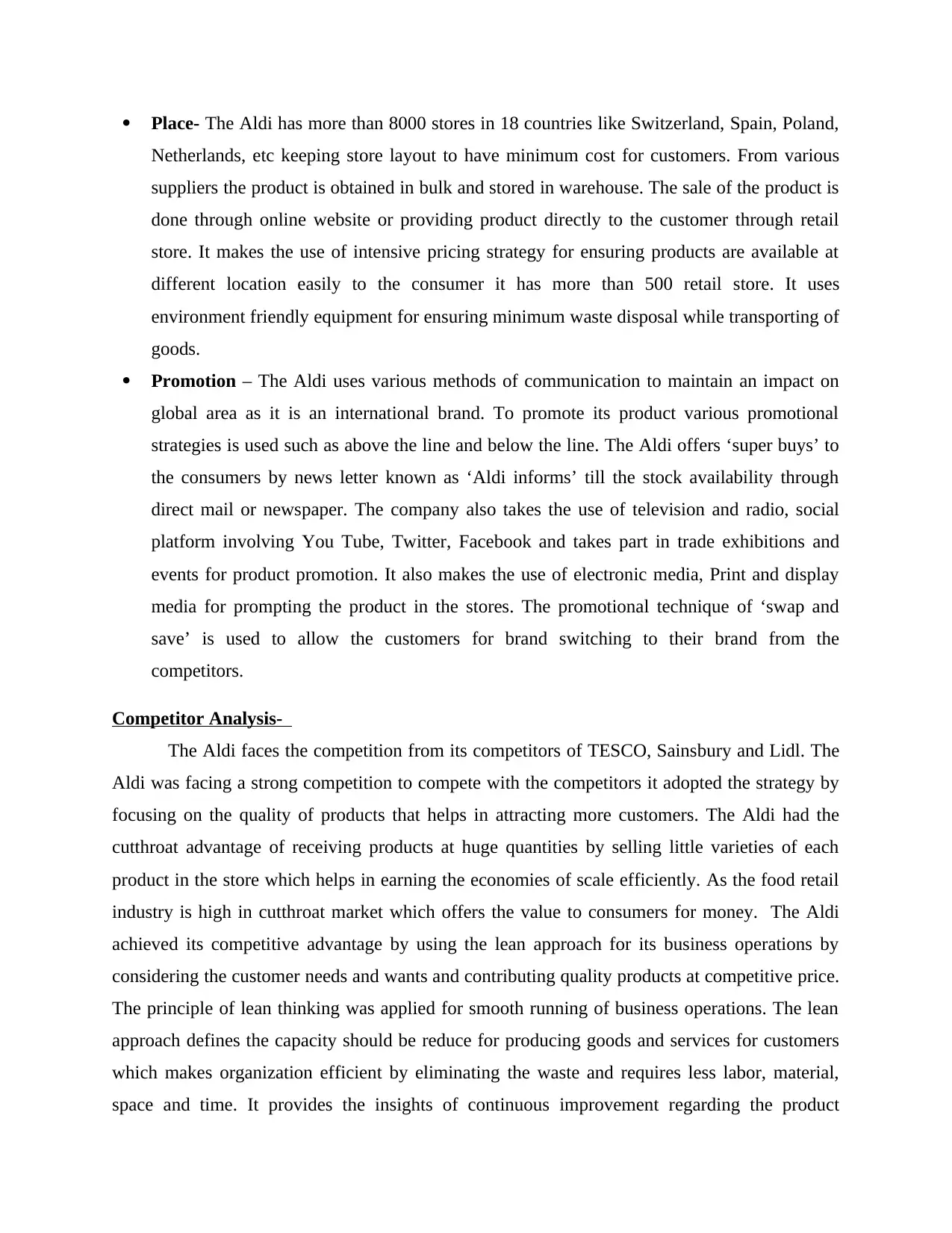
Place- The Aldi has more than 8000 stores in 18 countries like Switzerland, Spain, Poland,
Netherlands, etc keeping store layout to have minimum cost for customers. From various
suppliers the product is obtained in bulk and stored in warehouse. The sale of the product is
done through online website or providing product directly to the customer through retail
store. It makes the use of intensive pricing strategy for ensuring products are available at
different location easily to the consumer it has more than 500 retail store. It uses
environment friendly equipment for ensuring minimum waste disposal while transporting of
goods.
Promotion – The Aldi uses various methods of communication to maintain an impact on
global area as it is an international brand. To promote its product various promotional
strategies is used such as above the line and below the line. The Aldi offers ‘super buys’ to
the consumers by news letter known as ‘Aldi informs’ till the stock availability through
direct mail or newspaper. The company also takes the use of television and radio, social
platform involving You Tube, Twitter, Facebook and takes part in trade exhibitions and
events for product promotion. It also makes the use of electronic media, Print and display
media for prompting the product in the stores. The promotional technique of ‘swap and
save’ is used to allow the customers for brand switching to their brand from the
competitors.
Competitor Analysis-
The Aldi faces the competition from its competitors of TESCO, Sainsbury and Lidl. The
Aldi was facing a strong competition to compete with the competitors it adopted the strategy by
focusing on the quality of products that helps in attracting more customers. The Aldi had the
cutthroat advantage of receiving products at huge quantities by selling little varieties of each
product in the store which helps in earning the economies of scale efficiently. As the food retail
industry is high in cutthroat market which offers the value to consumers for money. The Aldi
achieved its competitive advantage by using the lean approach for its business operations by
considering the customer needs and wants and contributing quality products at competitive price.
The principle of lean thinking was applied for smooth running of business operations. The lean
approach defines the capacity should be reduce for producing goods and services for customers
which makes organization efficient by eliminating the waste and requires less labor, material,
space and time. It provides the insights of continuous improvement regarding the product
Netherlands, etc keeping store layout to have minimum cost for customers. From various
suppliers the product is obtained in bulk and stored in warehouse. The sale of the product is
done through online website or providing product directly to the customer through retail
store. It makes the use of intensive pricing strategy for ensuring products are available at
different location easily to the consumer it has more than 500 retail store. It uses
environment friendly equipment for ensuring minimum waste disposal while transporting of
goods.
Promotion – The Aldi uses various methods of communication to maintain an impact on
global area as it is an international brand. To promote its product various promotional
strategies is used such as above the line and below the line. The Aldi offers ‘super buys’ to
the consumers by news letter known as ‘Aldi informs’ till the stock availability through
direct mail or newspaper. The company also takes the use of television and radio, social
platform involving You Tube, Twitter, Facebook and takes part in trade exhibitions and
events for product promotion. It also makes the use of electronic media, Print and display
media for prompting the product in the stores. The promotional technique of ‘swap and
save’ is used to allow the customers for brand switching to their brand from the
competitors.
Competitor Analysis-
The Aldi faces the competition from its competitors of TESCO, Sainsbury and Lidl. The
Aldi was facing a strong competition to compete with the competitors it adopted the strategy by
focusing on the quality of products that helps in attracting more customers. The Aldi had the
cutthroat advantage of receiving products at huge quantities by selling little varieties of each
product in the store which helps in earning the economies of scale efficiently. As the food retail
industry is high in cutthroat market which offers the value to consumers for money. The Aldi
achieved its competitive advantage by using the lean approach for its business operations by
considering the customer needs and wants and contributing quality products at competitive price.
The principle of lean thinking was applied for smooth running of business operations. The lean
approach defines the capacity should be reduce for producing goods and services for customers
which makes organization efficient by eliminating the waste and requires less labor, material,
space and time. It provides the insights of continuous improvement regarding the product
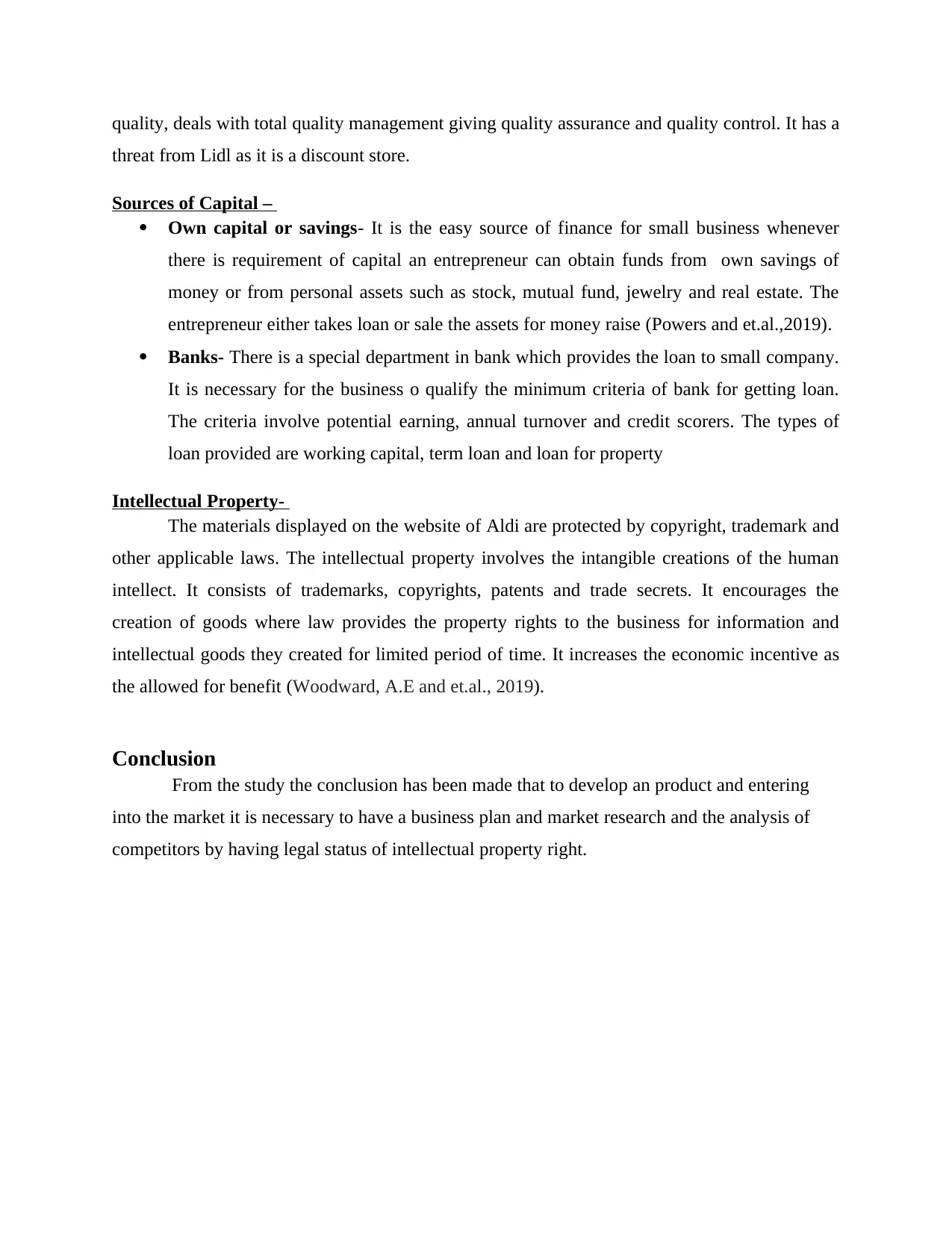
quality, deals with total quality management giving quality assurance and quality control. It has a
threat from Lidl as it is a discount store.
Sources of Capital –
Own capital or savings- It is the easy source of finance for small business whenever
there is requirement of capital an entrepreneur can obtain funds from own savings of
money or from personal assets such as stock, mutual fund, jewelry and real estate. The
entrepreneur either takes loan or sale the assets for money raise (Powers and et.al.,2019).
Banks- There is a special department in bank which provides the loan to small company.
It is necessary for the business o qualify the minimum criteria of bank for getting loan.
The criteria involve potential earning, annual turnover and credit scorers. The types of
loan provided are working capital, term loan and loan for property
Intellectual Property-
The materials displayed on the website of Aldi are protected by copyright, trademark and
other applicable laws. The intellectual property involves the intangible creations of the human
intellect. It consists of trademarks, copyrights, patents and trade secrets. It encourages the
creation of goods where law provides the property rights to the business for information and
intellectual goods they created for limited period of time. It increases the economic incentive as
the allowed for benefit (Woodward, A.E and et.al., 2019).
Conclusion
From the study the conclusion has been made that to develop an product and entering
into the market it is necessary to have a business plan and market research and the analysis of
competitors by having legal status of intellectual property right.
threat from Lidl as it is a discount store.
Sources of Capital –
Own capital or savings- It is the easy source of finance for small business whenever
there is requirement of capital an entrepreneur can obtain funds from own savings of
money or from personal assets such as stock, mutual fund, jewelry and real estate. The
entrepreneur either takes loan or sale the assets for money raise (Powers and et.al.,2019).
Banks- There is a special department in bank which provides the loan to small company.
It is necessary for the business o qualify the minimum criteria of bank for getting loan.
The criteria involve potential earning, annual turnover and credit scorers. The types of
loan provided are working capital, term loan and loan for property
Intellectual Property-
The materials displayed on the website of Aldi are protected by copyright, trademark and
other applicable laws. The intellectual property involves the intangible creations of the human
intellect. It consists of trademarks, copyrights, patents and trade secrets. It encourages the
creation of goods where law provides the property rights to the business for information and
intellectual goods they created for limited period of time. It increases the economic incentive as
the allowed for benefit (Woodward, A.E and et.al., 2019).
Conclusion
From the study the conclusion has been made that to develop an product and entering
into the market it is necessary to have a business plan and market research and the analysis of
competitors by having legal status of intellectual property right.
⊘ This is a preview!⊘
Do you want full access?
Subscribe today to unlock all pages.

Trusted by 1+ million students worldwide
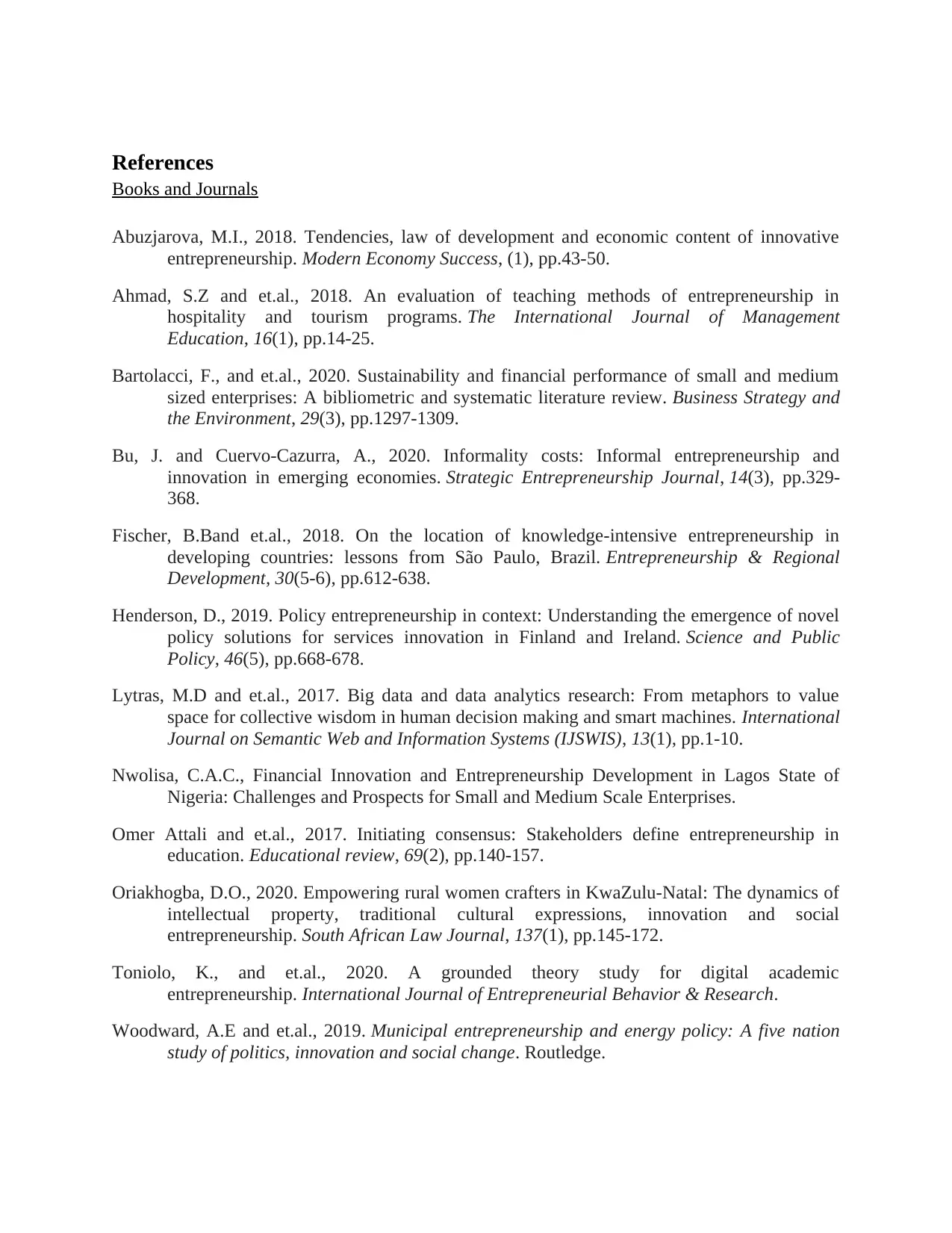
References
Books and Journals
Abuzjarova, M.I., 2018. Tendencies, law of development and economic content of innovative
entrepreneurship. Modern Economy Success, (1), pp.43-50.
Ahmad, S.Z and et.al., 2018. An evaluation of teaching methods of entrepreneurship in
hospitality and tourism programs. The International Journal of Management
Education, 16(1), pp.14-25.
Bartolacci, F., and et.al., 2020. Sustainability and financial performance of small and medium
sized enterprises: A bibliometric and systematic literature review. Business Strategy and
the Environment, 29(3), pp.1297-1309.
Bu, J. and Cuervo‐Cazurra, A., 2020. Informality costs: Informal entrepreneurship and
innovation in emerging economies. Strategic Entrepreneurship Journal, 14(3), pp.329-
368.
Fischer, B.Band et.al., 2018. On the location of knowledge-intensive entrepreneurship in
developing countries: lessons from São Paulo, Brazil. Entrepreneurship & Regional
Development, 30(5-6), pp.612-638.
Henderson, D., 2019. Policy entrepreneurship in context: Understanding the emergence of novel
policy solutions for services innovation in Finland and Ireland. Science and Public
Policy, 46(5), pp.668-678.
Lytras, M.D and et.al., 2017. Big data and data analytics research: From metaphors to value
space for collective wisdom in human decision making and smart machines. International
Journal on Semantic Web and Information Systems (IJSWIS), 13(1), pp.1-10.
Nwolisa, C.A.C., Financial Innovation and Entrepreneurship Development in Lagos State of
Nigeria: Challenges and Prospects for Small and Medium Scale Enterprises.
Omer Attali and et.al., 2017. Initiating consensus: Stakeholders define entrepreneurship in
education. Educational review, 69(2), pp.140-157.
Oriakhogba, D.O., 2020. Empowering rural women crafters in KwaZulu-Natal: The dynamics of
intellectual property, traditional cultural expressions, innovation and social
entrepreneurship. South African Law Journal, 137(1), pp.145-172.
Toniolo, K., and et.al., 2020. A grounded theory study for digital academic
entrepreneurship. International Journal of Entrepreneurial Behavior & Research.
Woodward, A.E and et.al., 2019. Municipal entrepreneurship and energy policy: A five nation
study of politics, innovation and social change. Routledge.
Books and Journals
Abuzjarova, M.I., 2018. Tendencies, law of development and economic content of innovative
entrepreneurship. Modern Economy Success, (1), pp.43-50.
Ahmad, S.Z and et.al., 2018. An evaluation of teaching methods of entrepreneurship in
hospitality and tourism programs. The International Journal of Management
Education, 16(1), pp.14-25.
Bartolacci, F., and et.al., 2020. Sustainability and financial performance of small and medium
sized enterprises: A bibliometric and systematic literature review. Business Strategy and
the Environment, 29(3), pp.1297-1309.
Bu, J. and Cuervo‐Cazurra, A., 2020. Informality costs: Informal entrepreneurship and
innovation in emerging economies. Strategic Entrepreneurship Journal, 14(3), pp.329-
368.
Fischer, B.Band et.al., 2018. On the location of knowledge-intensive entrepreneurship in
developing countries: lessons from São Paulo, Brazil. Entrepreneurship & Regional
Development, 30(5-6), pp.612-638.
Henderson, D., 2019. Policy entrepreneurship in context: Understanding the emergence of novel
policy solutions for services innovation in Finland and Ireland. Science and Public
Policy, 46(5), pp.668-678.
Lytras, M.D and et.al., 2017. Big data and data analytics research: From metaphors to value
space for collective wisdom in human decision making and smart machines. International
Journal on Semantic Web and Information Systems (IJSWIS), 13(1), pp.1-10.
Nwolisa, C.A.C., Financial Innovation and Entrepreneurship Development in Lagos State of
Nigeria: Challenges and Prospects for Small and Medium Scale Enterprises.
Omer Attali and et.al., 2017. Initiating consensus: Stakeholders define entrepreneurship in
education. Educational review, 69(2), pp.140-157.
Oriakhogba, D.O., 2020. Empowering rural women crafters in KwaZulu-Natal: The dynamics of
intellectual property, traditional cultural expressions, innovation and social
entrepreneurship. South African Law Journal, 137(1), pp.145-172.
Toniolo, K., and et.al., 2020. A grounded theory study for digital academic
entrepreneurship. International Journal of Entrepreneurial Behavior & Research.
Woodward, A.E and et.al., 2019. Municipal entrepreneurship and energy policy: A five nation
study of politics, innovation and social change. Routledge.
Paraphrase This Document
Need a fresh take? Get an instant paraphrase of this document with our AI Paraphraser

1 out of 11
Related Documents
Your All-in-One AI-Powered Toolkit for Academic Success.
+13062052269
info@desklib.com
Available 24*7 on WhatsApp / Email
![[object Object]](/_next/static/media/star-bottom.7253800d.svg)
Unlock your academic potential
Copyright © 2020–2025 A2Z Services. All Rights Reserved. Developed and managed by ZUCOL.





